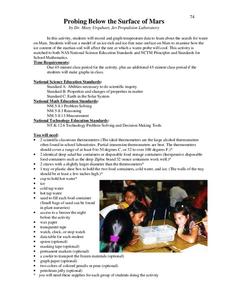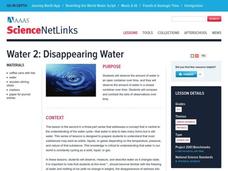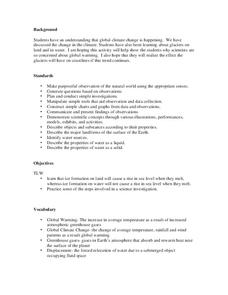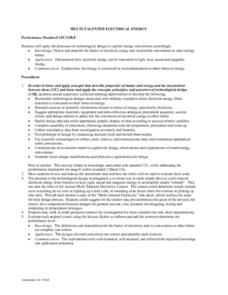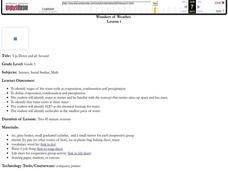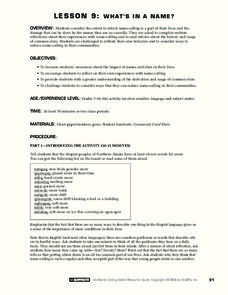Curated OER
Probing Below the Surface of Mars
Students simulate the search for water in Mars using simple apparatus. In this space science lesson, students explain how soil temperature affects the cooling of probes. They graph the data collected from the simulation.
Curated OER
Disappearing Water
Young scholars explore the water cycle. For this earth science lesson, students observe and measure water in a closed container and in an open container. Young scholars record their observations and compare their sets of data to draw...
Curated OER
Weather Dot Com
Students examine the need for a standard unit of temperature and measure temperature with a thermometer. They discuss the details of a thermometer and the calibrations used, record temperature data for inside and outside, explore...
Virginia Department of Education
Molar Heat of Fusion for Water
How can you describe heat of fusion in a way the class understands and relates the importance of this concept to present day issues? In this third lesson of the series, learners conduct an experiment, demonstrating the flow of heat...
Information is Beautiful
How Many Gigatons of Carbon Dioxide...?
Here is an interesting infographic that presents information on the amount of carbon dioxide we can safely release into the atmosphere compared to the actual amount we have released to date.
Curated OER
From Liquid to Gas
Students observe an experiment. In this water lesson, students observe as water is changed into vapor. They record their observations by completing a data sheet.
Curated OER
What's Under There?
Students determine ways to make "observations" about unknowns, such as the land beneath an ice sheet or the interior of the Earth, using tools other than sight. They build "mystery boxes" and exchange them with other groups to "map"...
Center for Learning in Action
Water – Changing States (Part 2)
Here is part two of a two-part lesson plan in which scholars investigate the changing states of water—liquid, solid, and gas—and how energy from heat changes its molecules. With grand conversation, two demonstrations, and one...
Curated OER
Ice Ain't Easy
Students are introduced to the laws of thermodynamics. The 1st law of thermodynamics states that the energy must be conserved when two objects of different temperatures come in contact. If one object gains energy, the other object must...
Curated OER
The Energy Debate - Sea Level Rise
Students comprehend the impact of global warming on our coastal cities. They appreciate how geographic information systems can be used to represent scientific data. Students research the melting of the ice caps in Antarctica and the Arctic.
Curated OER
Using the Scientific Method to Determine Which Conditions Best Favor Plant Growth
Seventh graders examine how the environment can affect biological processes. They identify the best conditions for the germination of bean seeds. They record and analyze their data. They write about their observations in an essay.
Curated OER
Dimming the Sun
Students collect, interpret and analyze weather variable data. They describe atmospheric variables that affect evaporation. Students create graphs and analyze the information collected.
Curated OER
Reflecting on Reflectivity
Students plan and construct a "mini-lab" to measure the reflectivity of different earth surfaces. They measure reflectivity of materials, including ice, soil, rocks, etc., and then extrapolate from what they have learned to consider the...
Curated OER
Glacier Dynamics
Learners create flubber glaciers. In this glacier dynamics instructional activity, students experiment factors that may affect glacier speed. Factors include slope, ice temperature, and basal conditions. Learners develop hypothesis,...
Curated OER
Weather, Sea Level Rise and Climate Change Course
Young scholars explain the impact of glacial melting to global climate change. In this environmental science lesson plan, students design an experiment to investigate the effect of salinity change to melting glaciers. They share their...
Curated OER
Temperature Change and the States of Matter
Tenth graders observe the processes of evaporation, condensation, melting, freezing, boiling, and sublimation. They do a quantitative investigation of the freezing of water, to explore explanations that involve particles.
Curated OER
Wet Weather, Wet Climate
Students discover the differences between weather and climate in this long-term lesson plan introduction. They create rain gauges and practice reading rainfall measurements, view a website showing the cloud cover in their location and...
Curated OER
Global Climate Change
Second graders investigate the effect of melting glaciers to sea level. In this earth science lesson, 2nd graders simulate the process in the lab by conducting an experiment using ice cubes and clay. They explain the consequences of...
Curated OER
Law of Conservation of Mass
Students work in small groups. They grab a handful of ice, and place the ice in an empty beaker of ice using a triple beam balance. Students heat up the beaker of ice over a hot plat until the ice has changed into water. They measure...
Curated OER
Multi-Talented Electrical Energy
Students explore energy conversions by demonstrating the conversion of electrical energy into light, heat, sound, and magnetic energy. Students create a simple device that converts electrical energy from batteries to heat, light, sound...
Curated OER
Ice Ain't Easy
Students are told that objects in contact with one another reach an equilibrium temperature. A hot object placed in a cool liquid always cool off. It never happens that the object gets hotter and cool liquid gets colder. Students predict...
Curated OER
Wonders of Weather
Fourth graders complete activities to study weather and the water cycle. In this water cycle instructional activity, 4th graders observe a demonstration of the three stages of water. Students work in groups to complete a water cycle lab...
Curated OER
Daily Survival Requirements of Water
Students will use inquiry science to complete an investigation. They create hypotheses predicting the changes water undergoes in becoming ice and determine how much ice needs to be melted to create one 8 oz. glass of water.
Curated OER
What's in a Name?
Students examine how name-calling is a part of their lives and how it affects others. They write reflections of times in their lives when name calling and slurs have been involved. Also, they read articles that discuss the use of slurs...


